Detecting 3D Salinity Anomalies from Soil Sampling Points: A Case Study of the Yellow River Delta, China
Abstract
:1. Introduction
2. Materials and Methods
2.1. Study Area
2.2. Data Sources
2.2.1. Field Sampling
2.2.2. Soil Analysis
2.3. 3D-SSAS
2.3.1. Construction of 3D Soil-Salinity Voxel Data Set
2.3.2. Calculation of Local Anomaly Index (LAI)
2.3.3. Threshold Selection and AV Filtering
2.3.4. Construction of 3D ASA Structure
3. Results
3.1. Sampling Data Analysis
3.2. Three-Dimensional Soil-Salinity Voxel Data Set
3.3. Threshold and AV Sets
3.4. Three-Dimensional Structure of ASA
3.4.1. ASA1
3.4.2. ASA2
3.4.3. ASA3
4. Discussion
4.1. A Discussion of the 3D-SSAS Method
4.2. Ecological, Agricultural, and Environmental Impacts
5. Conclusions
Author Contributions
Funding
Data Availability Statement
Acknowledgments
Conflicts of Interest
References
- Dehaan, R.; Taylor, G. Field-derived spectra of salinized soils and vegetation as indicators of irrigation-induced soil salinization. Remote Sens. Environ. 2002, 80, 406–417. [Google Scholar] [CrossRef]
- Li, J.; Pu, L.; Han, M.; Zhu, M.; Zhang, R.; Xiang, Y. Soil salinization research in China: Advances and prospects. J. Geogr. Sci. 2014, 24, 943–960. [Google Scholar] [CrossRef]
- Wang, X.P.; Yang, J.S.; Liu, G.M.; Yao, R.J.; Yu, S.P. Impact of irrigation volume and water salinity on winter wheat productivity and soil salinity distribution. Agric. Water Manag. 2015, 149, 44–54. [Google Scholar] [CrossRef]
- Machado, R.M.A.; Serralheiro, R.P. Soil salinity: Effect on vegetable crop growth. Management practices to prevent and mitigate soil salinization. Horticulturae 2017, 3, 30. [Google Scholar] [CrossRef]
- Pessoa, L.G.M.; Freire, M.B.G.d.S.; Green, C.H.M.; Miranda, M.F.A.; Filho, J.C.d.A.; Pessoa, W.R.L.S. Assessment of soil salinity status under different land-use conditions in the semiarid region of Northeastern Brazil. Ecol. Indic. 2022, 141, 109139. [Google Scholar] [CrossRef]
- Gong, L.; Ran, Q.; He, G.; Tiyip, T. A soil quality assessment under different land use types in Keriya river basin, Southern Xinjiang, China. Soil Tillage Res. 2015, 146, 223–229. [Google Scholar] [CrossRef]
- Akça, E.; Aydin, M.; Kapur, S.; Kume, T.; Nagano, T.; Watanabe, T.; Çilek, A.; Zorlu, K. Long-term monitoring of soil salinity in a semi-arid environment of Turkey. Catena 2020, 193, 104614. [Google Scholar] [CrossRef]
- Onkware, A.O. Effect of soil salinity on plant distribution and production at Loburu delta, Lake Bogoria National Reserve, Kenya. Austral Ecol. 2000, 25, 140–149. [Google Scholar] [CrossRef]
- Fereres, E.; Soriano, M.A. Deficit irrigation for reducing agricultural water use. J. Exp. Bot. 2007, 58, 147–159. [Google Scholar] [CrossRef]
- Bekmirzaev, G.; Ouddane, B.; Beltrao, J.; Khamidov, M.; Fujii, Y.; Sugiyama, A. Effects of Salinity on the Macro- and Micronutrient Contents of a Halophytic Plant Species (Portulaca oleracea L.). Land 2021, 10, 481. [Google Scholar] [CrossRef]
- Li, X.; Guo, M. The Impact of Salinization and Wind Erosion on the Texture of Surface Soils: An Investigation of Paired Samples from Soils with and without Salt Crust. Land 2022, 11, 999. [Google Scholar] [CrossRef]
- Yang, W.; Song, X.; He, Y.; Chen, B.; Zhou, Y.; Chen, J. Distribution of Soil Organic Carbon Density Fractions in Aggregates as Influenced by Salts and Microbial Community. Land 2023, 12, 2024. [Google Scholar] [CrossRef]
- Jordán, M.; Navarro-Pedreno, J.; García-Sánchez, E.; Mateu, J.; Juan, P. Spatial dynamics of soil salinity under arid and semi-arid conditions: Geological and environmental implications. Environ. Geol. 2004, 45, 448–456. [Google Scholar] [CrossRef]
- Zhang, Y.; Miao, Q.; Li, R.; Sun, M.; Yang, X.; Wang, W.; Huang, Y.; Feng, W. Distribution and Variation of Soil Water and Salt before and after Autumn Irrigation. Land 2024, 13, 773. [Google Scholar] [CrossRef]
- Akramkhanov, A.; Martius, C.; Park, S.; Hendrickx, J. Environmental factors of spatial distribution of soil salinity on flat irrigated terrain. Geoderma 2011, 163, 55–62. [Google Scholar] [CrossRef]
- Bannari, A.; Abuelgasim, A. Potential and limits of vegetation indices compared to evaporite mineral indices for soil salinity discrimination and mapping. SOIL Discuss. 2021, 2021, 1–48. [Google Scholar]
- Wang, Y.; Deng, C.; Liu, Y.; Niu, Z.; Li, Y. Identifying change in spatial accumulation of soil salinity in an inland river watershed, China. Sci. Total Environ. 2018, 621, 177–185. [Google Scholar] [CrossRef]
- Wang, F.; Shi, Z.; Biswas, A.; Yang, S.; Ding, J. Multi-algorithm comparison for predicting soil salinity. Geoderma 2020, 365, 114211. [Google Scholar] [CrossRef]
- Naimi, S.; Ayoubi, S.; Zeraatpisheh, M.; Dematte, J.A.M. Ground observations and environmental covariates integration for mapping of soil salinity: A machine learning-based approach. Remote Sens. 2021, 13, 4825. [Google Scholar] [CrossRef]
- Gu, Q.; Han, Y.; Xu, Y.; Ge, H.; Li, X. Extraction of saline soil distributions using different salinity indices and deep neural networks. Remote Sens. 2022, 14, 4647. [Google Scholar] [CrossRef]
- Peng, J.; Biswas, A.; Jiang, Q.; Zhao, R.; Hu, J.; Hu, B.; Shi, Z. Estimating soil salinity from remote sensing and terrain data in southern Xinjiang Province, China. Geoderma 2019, 337, 1309–1319. [Google Scholar] [CrossRef]
- Wang, N.; Xue, J.; Peng, J.; Biswas, A.; He, Y.; Shi, Z. Integrating remote sensing and landscape characteristics to estimate soil salinity using machine learning methods: A case study from Southern Xinjiang, China. Remote Sens. 2020, 12, 4118. [Google Scholar] [CrossRef]
- Zovko, M.; Romić, D.; Colombo, C.; Di Iorio, E.; Romić, M.; Buttafuoco, G.; Castrignanò, A. A geostatistical Vis-NIR spectroscopy index to assess the incipient soil salinization in the Neretva River valley, Croatia. Geoderma 2018, 332, 60–72. [Google Scholar] [CrossRef]
- Fu, X.; Liu, G.; Huang, C.; Liu, Q. Analysis of ecological characteristics of coastal zone in Yellow River Delta under dam disturbance. J. Geo-Inform. Sci. 2011, 13, 797–803. [Google Scholar] [CrossRef]
- Singh, A. Soil salinization management for sustainable development: A review. J. Environ. Manag. 2021, 277, 111383. [Google Scholar] [CrossRef]
- Zhang, H.; Fu, X.; Zhang, Y.; Qi, Z.; Zhang, H.; Xu, Z. Mapping Multi-Depth Soil Salinity Using Remote Sensing-Enabled Machine Learning in the Yellow River Delta, China. Remote Sens. 2023, 15, 5640. [Google Scholar] [CrossRef]
- Guan, Y.; Liu, G.; Wang, J. Regionalization of Salt-affected Land for Amelioration in the Yellow River Delta Based on GIS. Acta Geogr. Sin. 2001, 56, 205–212. [Google Scholar]
- De Sosa, L.L.; Martin-Palomo, M.J.; Castro-Valdecantos, P.; Madejon, E. Agricultural use of compost under different irrigation strategies in a hedgerow olive grove under Mediterranean conditions—A comparison with traditional systems. Soil 2023, 9, 325–338. [Google Scholar] [CrossRef]
- Chen, H.; Liang, M.; Liu, W.; Wang, W.; Liu, P.X. An approach to boundary detection for 3D point clouds based on DBSCAN clustering. Pattern Recognit. 2022, 124, 108431. [Google Scholar] [CrossRef]
- Zhang, X.; Wang, Z.; Song, X.; Liu, P.; Li, S.; Yang, X. Effect of sampling on spatial variability in soil salinity in the Yellow River Delta Area. Resour. Sci. 2016, 12, 2375–2382. [Google Scholar]
- Fan, X.; Pedroli, B.; Liu, G.; Liu, Q.; Liu, H.; Shu, L. Soil salinity development in the yellow river delta in relation to groundwater dynamics. Land Degrad. Dev. 2012, 23, 175–189. [Google Scholar] [CrossRef]
- Gulzar, S.; Khan, M.A.; Ungar, I.A. Salt tolerance of a coastal salt marsh grass. Commun. Soil Sci. Plant Anal. 2003, 34, 2595–2605. [Google Scholar] [CrossRef]
- Yang, L.; Yan, C.X.; Ni, L.H.; Ting, L.T.; Jun, G.; Qiang, F.U. Relationships between Salinity, Conductivity and Water Content of Soils in a Pristine Tidal Flat in Jiangsu Province. Water Sav. Irrig. 2015, 8, 4–7. [Google Scholar]
- Qin, Z.J.; Bo, C.J.; Guang, Y.C.; Gui, G.A.; Xiu, L.J.; Long, Y.Y. Growth adaptability of some cultivars(lines) of warm-season turfgrass in coastal beach and their influence on soil salinity. J. Plant Resour. Environ. 2010, 19, 48–54. [Google Scholar]
- Ce, Y.; Huanyu, C.; Jinsong, L.I.; Yu, T.; Xiaohui, F.; Xiaojing, L.; Kai, G. Soil improving effect of Suaeda salsa on heavy coastal saline-alkaline land. Chin. J. Eco-Agric. 2019, 27, 1578–1586. [Google Scholar]
- Fan, X.; Liu, G.; Tang, Z.; Shu, L. Analysis on main contributors influencing soil salinization of Yellow River Delta. J. Soil Water Conserv. 2010, 24, 139–144. [Google Scholar]
- Qing, W.; Meng, L.; Dong-Dong, Q.; Tian, X.; Wei, S.; Bao-Shan, C.; Environment, S.O.; University, B.N. Effect of hydrological characteristics on the recruitment of Suaeda salsa in coastal salt marshes. J. Nat. Resour. 2019, 34, 2569–2579. [Google Scholar] [CrossRef]
- Wang, Z.; Zhao, G.; Gao, M.; Chang, C. Spatial variability of soil salinity in coastal saline soil at different scales in the Yellow River Delta, China. Environ. Monit. Assess. 2017, 189, 80. [Google Scholar] [CrossRef]
- Bazihizina, N.; Barrett-Lennard, E.G.; Colmer, T.D. Plant growth and physiology under heterogeneous salinity. Plant Soil 2012, 354, 1–19. [Google Scholar] [CrossRef]
- Valenzuela, F.J.; Reineke, D.; Leventini, D.; Chen, C.C.L.; Barrett-Lennard, E.G.; Colmer, T.D.; Dodd, I.C.; Shabala, S.; Brown, P.; Bazihizina, N. Plant responses to heterogeneous salinity: Agronomic relevance and research priorities. Ann. Bot. 2022, 129, 499–518. [Google Scholar] [CrossRef]
- Reynolds, H.L.; Hungate, B.A.; Chapin Iii, F.; D’Antonio, C.M. Soil heterogeneity and plant competition in an annual grassland. Ecology 1997, 78, 2076–2090. [Google Scholar] [CrossRef]
- Moffett, K.B.; Robinson, D.A.; Gorelick, S.M. Relationship of salt marsh vegetation zonation to spatial patterns in soil moisture, salinity, and topography. Ecosystems 2010, 13, 1287–1302. [Google Scholar] [CrossRef]
- Liu, L.; Wu, Y.; Yin, M.; Ma, X.; Yu, X.; Guo, X.; Du, N.; Eller, F.; Guo, W. Soil salinity, not plant genotype or geographical distance, shapes soil microbial community of a reed wetland at a fine scale in the Yellow River Delta. Sci. Total Environ. 2023, 856, 159136. [Google Scholar] [CrossRef] [PubMed]
- Gilliam, F.S.; Dick, D.A. Spatial heterogeneity of soil nutrients and plant species in herb-dominated communities of contrasting land use. Plant Ecol. 2010, 209, 83–94. [Google Scholar] [CrossRef]
- Zhao, S.; Liu, J.J.; Banerjee, S.; White, J.F.; Zhou, N.; Zhao, Z.Y.; Zhang, K.; Hu, M.F.; Kingsley, K.; Tian, C.Y. Not by salinity alone: How environmental factors shape fungal communities in saline soils. Soil Sci. Soc. Am. J. 2019, 83, 1387–1398. [Google Scholar] [CrossRef]
- Li, Y.; Kang, E.; Song, B.; Wang, J.; Zhang, X.; Wang, J.; Li, M.; Yan, L.; Yan, Z.; Zhang, K. Soil salinity and nutrients availability drive patterns in bacterial community and diversity along succession gradient in the Yellow River Delta. Estuar. Coast. Shelf Sci. 2021, 262, 107621. [Google Scholar] [CrossRef]
- Adamchuk, V.I.; Ferguson, R.B.; Hergert, G.W. Soil heterogeneity and crop growth. In Precision Crop Protection—The Challenge and Use of Heterogeneity; Springer: Berlin/Heidelberg, Germany, 2010; pp. 3–16. [Google Scholar]
- Wang, Y.; Liu, G.; Zhao, Z. Spatial heterogeneity of soil fertility in coastal zones: A case study of the Yellow River Delta, China. J. Soils Sediments 2021, 21, 1826–1839. [Google Scholar] [CrossRef]
- Russo, D. A stochastic approach to the crop yield-irrigation relationships in heterogeneous soils: I. Analysis of the field spatial variability. Soil Sci. Soc. Am. J. 1986, 50, 736–745. [Google Scholar] [CrossRef]
- Patzold, S.; Mertens, F.M.; Bornemann, L.; Koleczek, B.; Franke, J.; Feilhauer, H.; Welp, G. Soil heterogeneity at the field scale: A challenge for precision crop protection. Precis. Agric. 2008, 9, 367–390. [Google Scholar] [CrossRef]
- Liu, Y.; Ma, C.; Yang, Z.; Fan, X. Ecological Security of Desert–Oasis Areas in the Yellow River Basin, China. Land 2023, 12, 2080. [Google Scholar] [CrossRef]
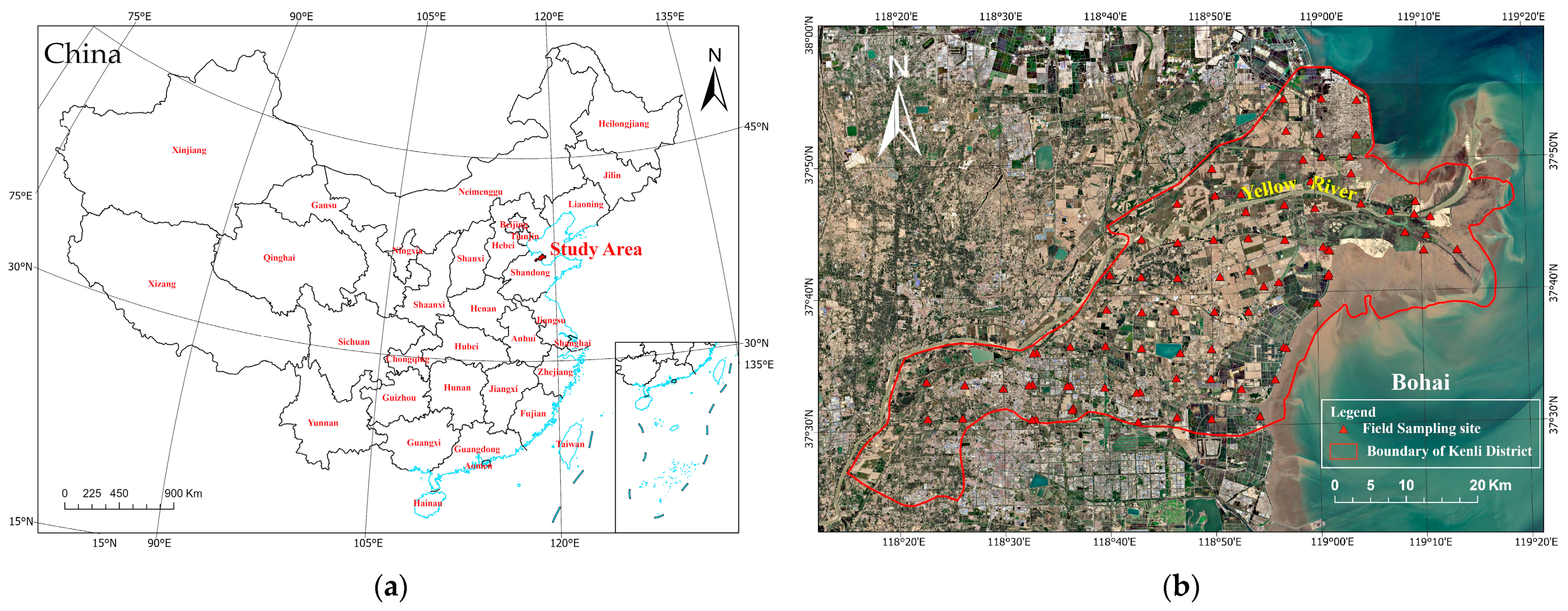
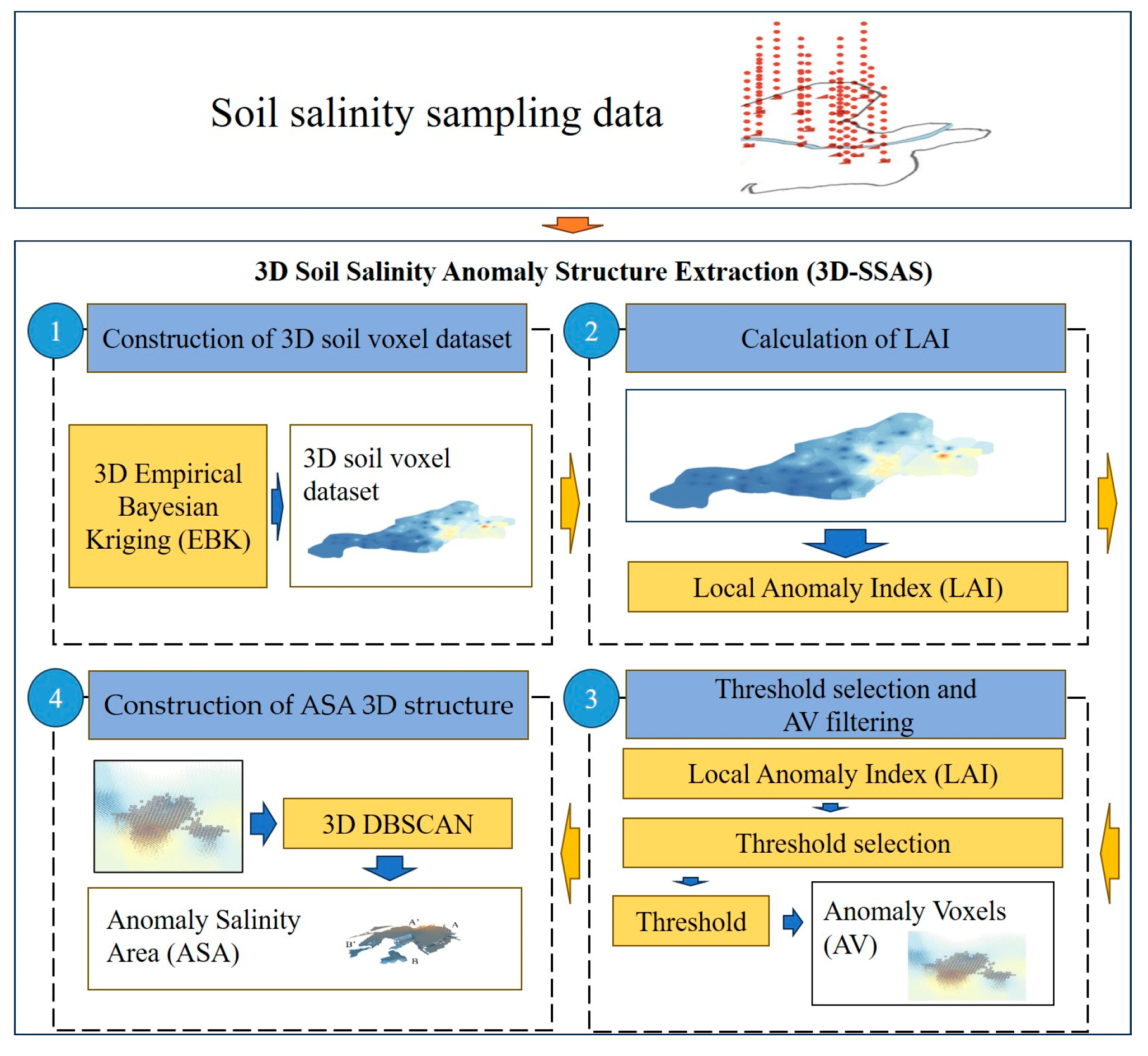
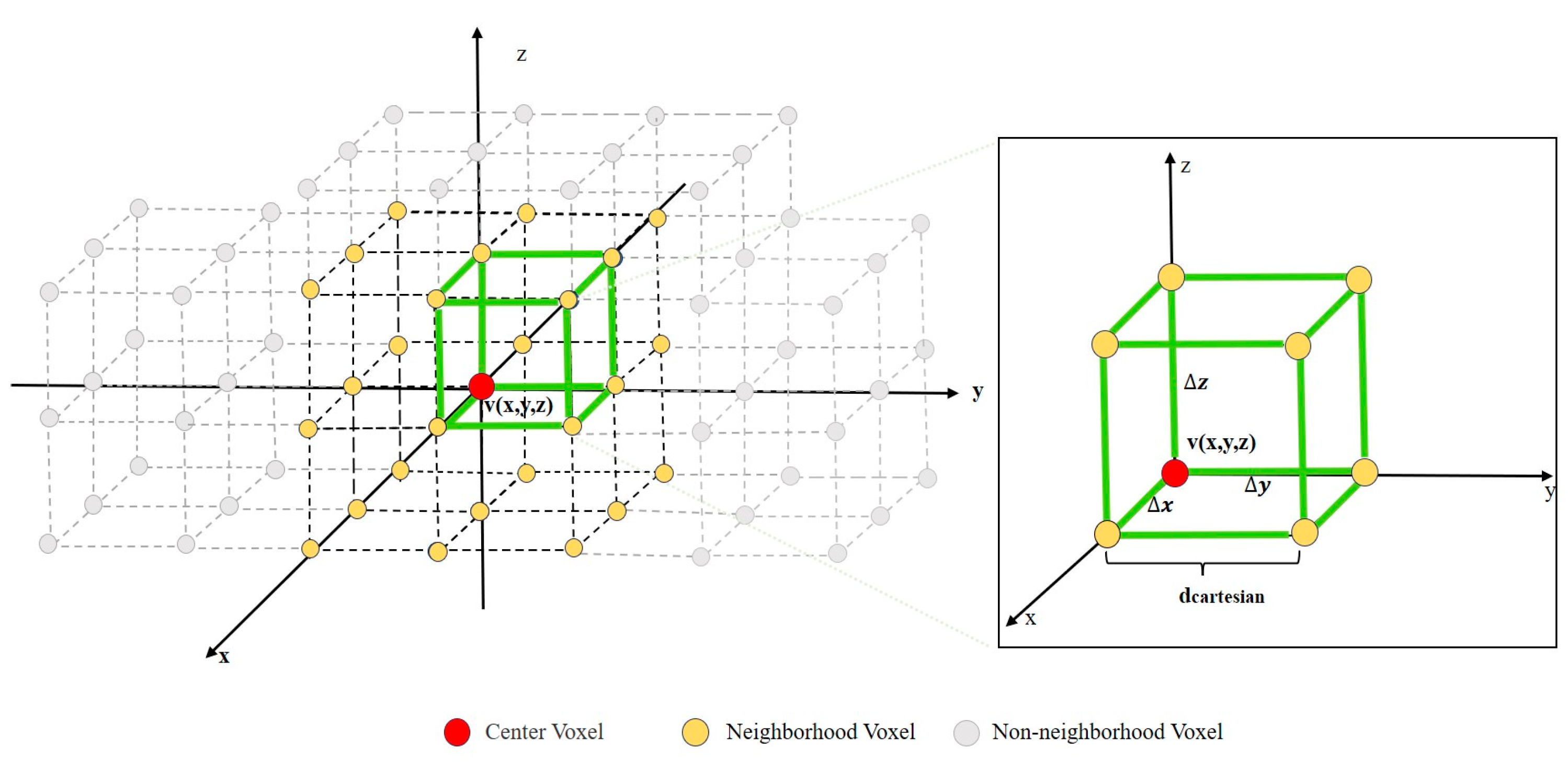

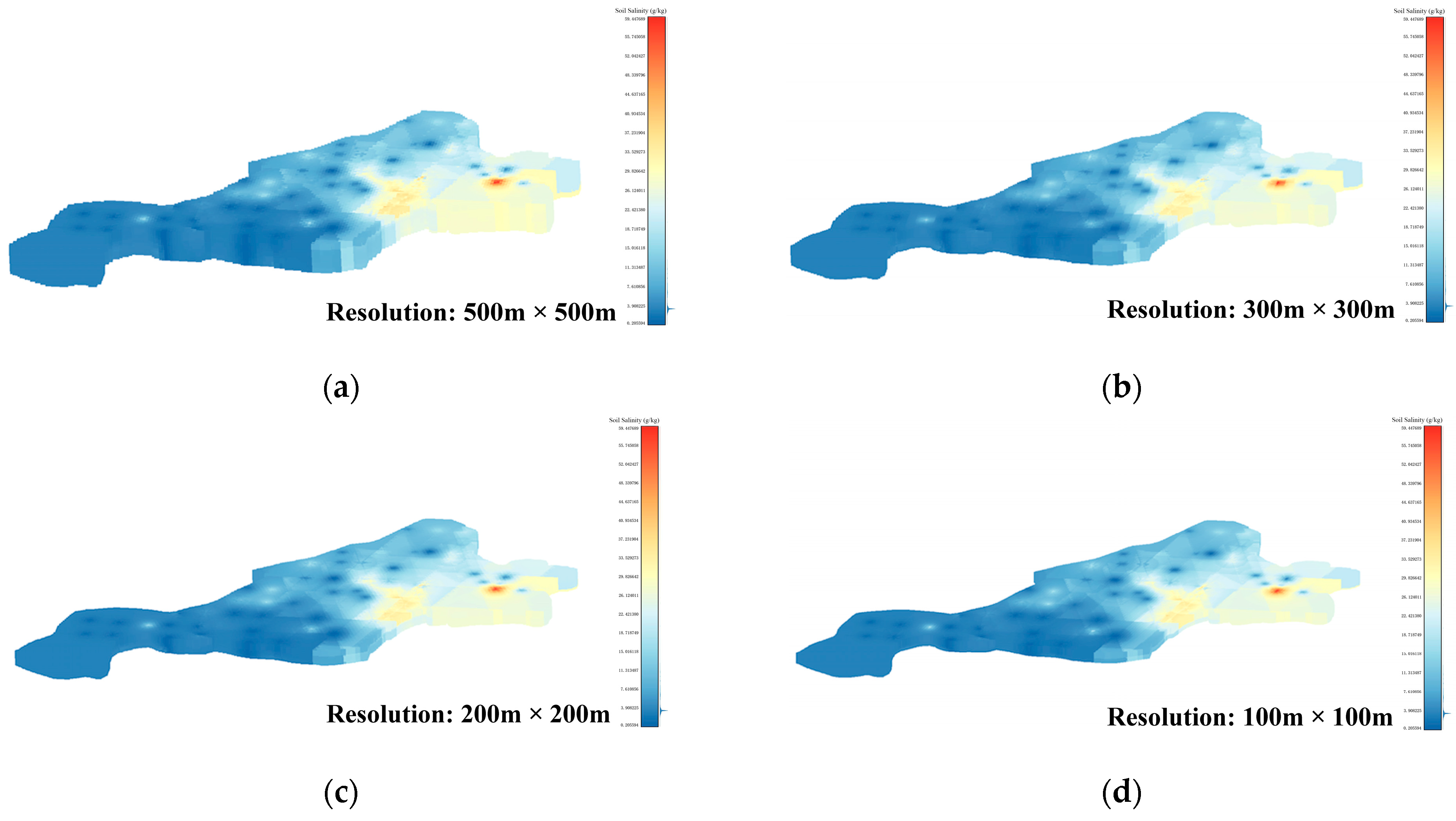
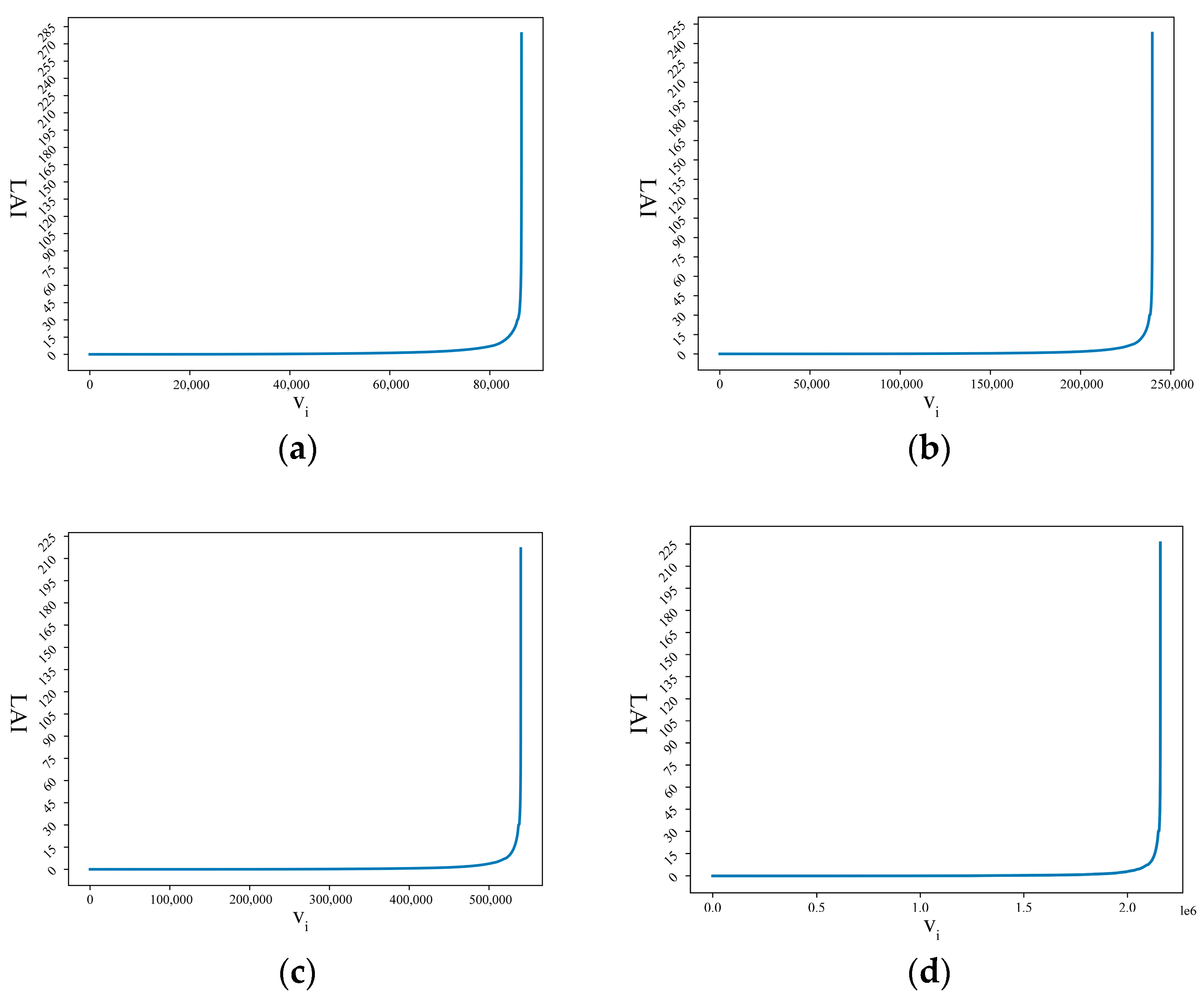

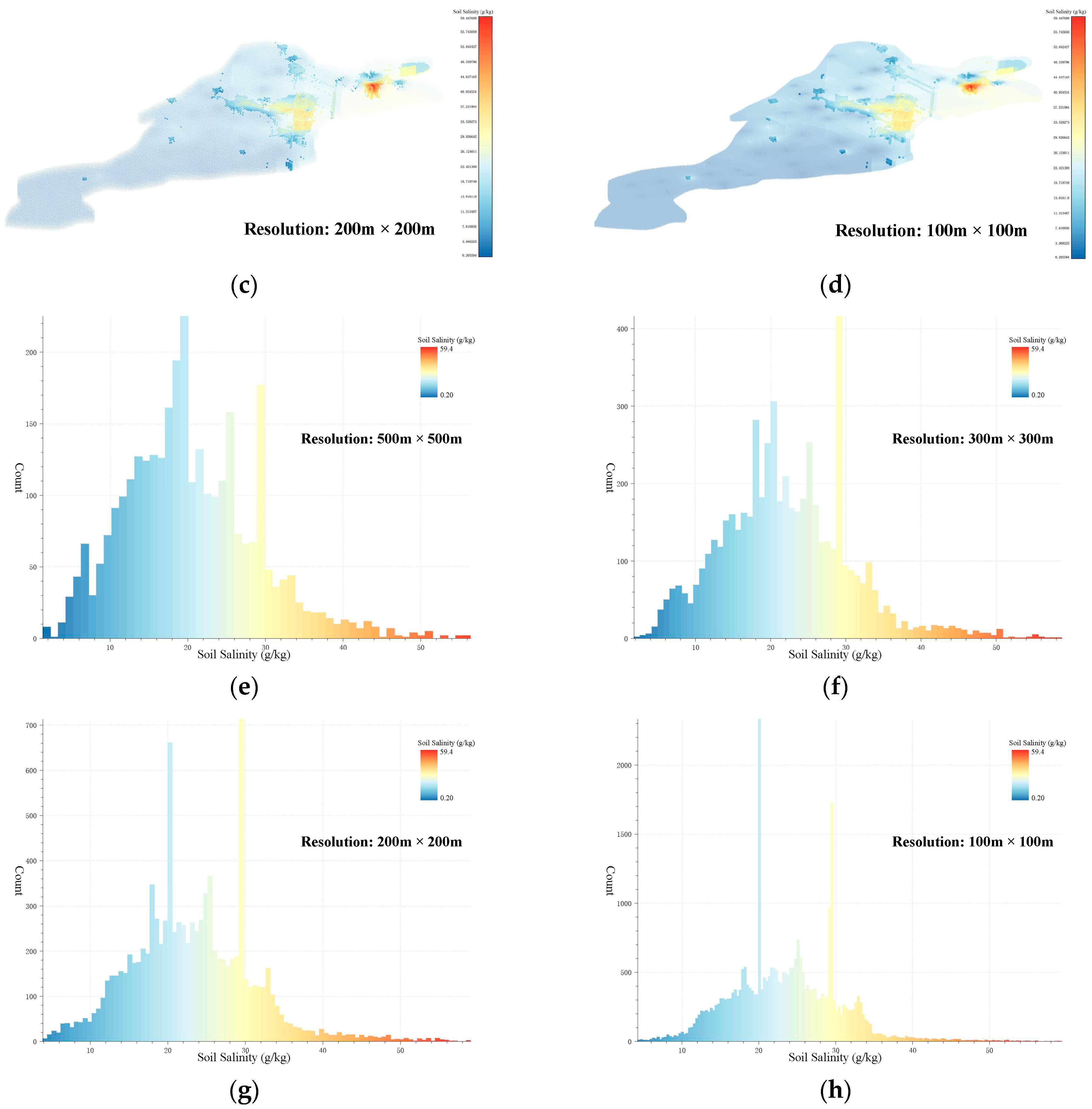
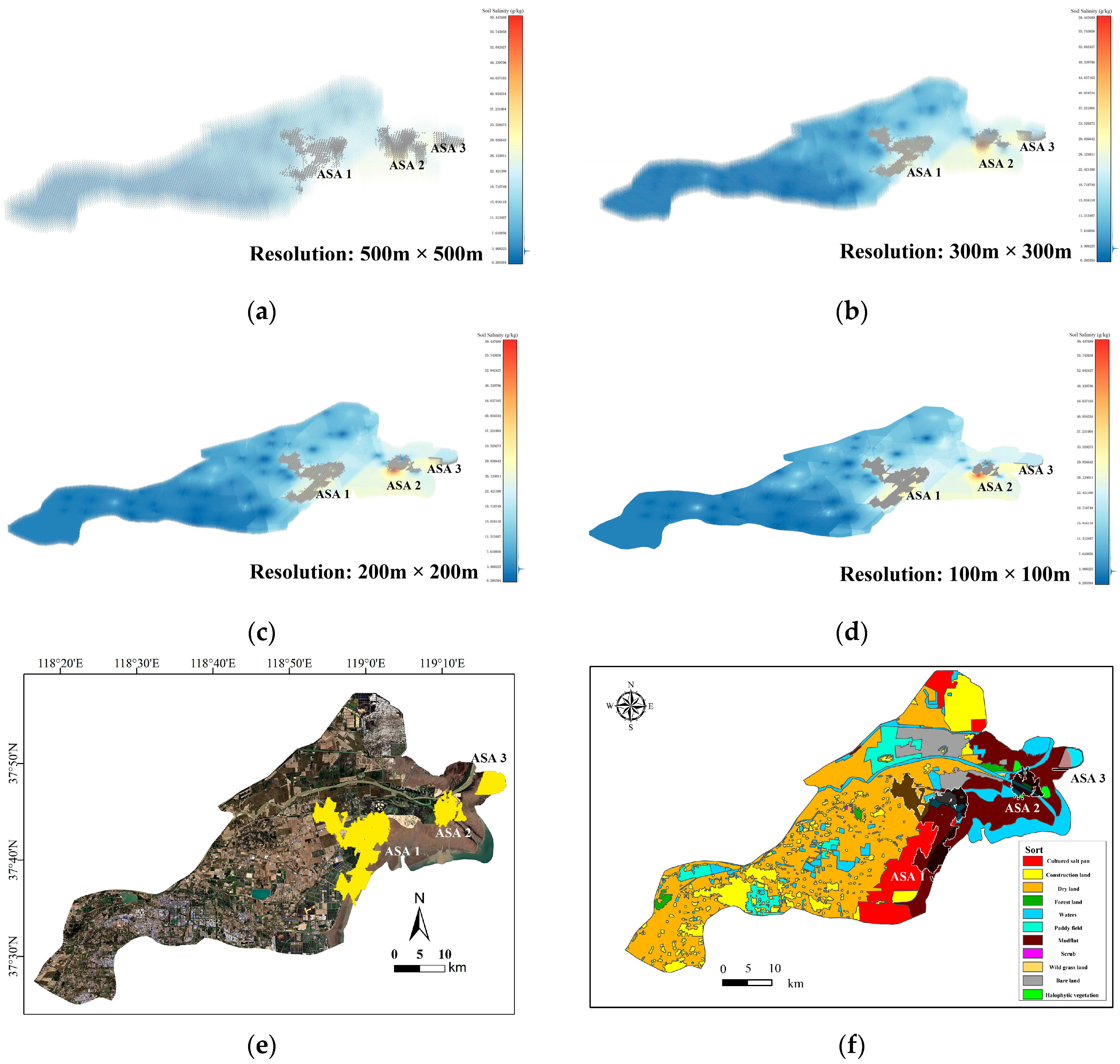

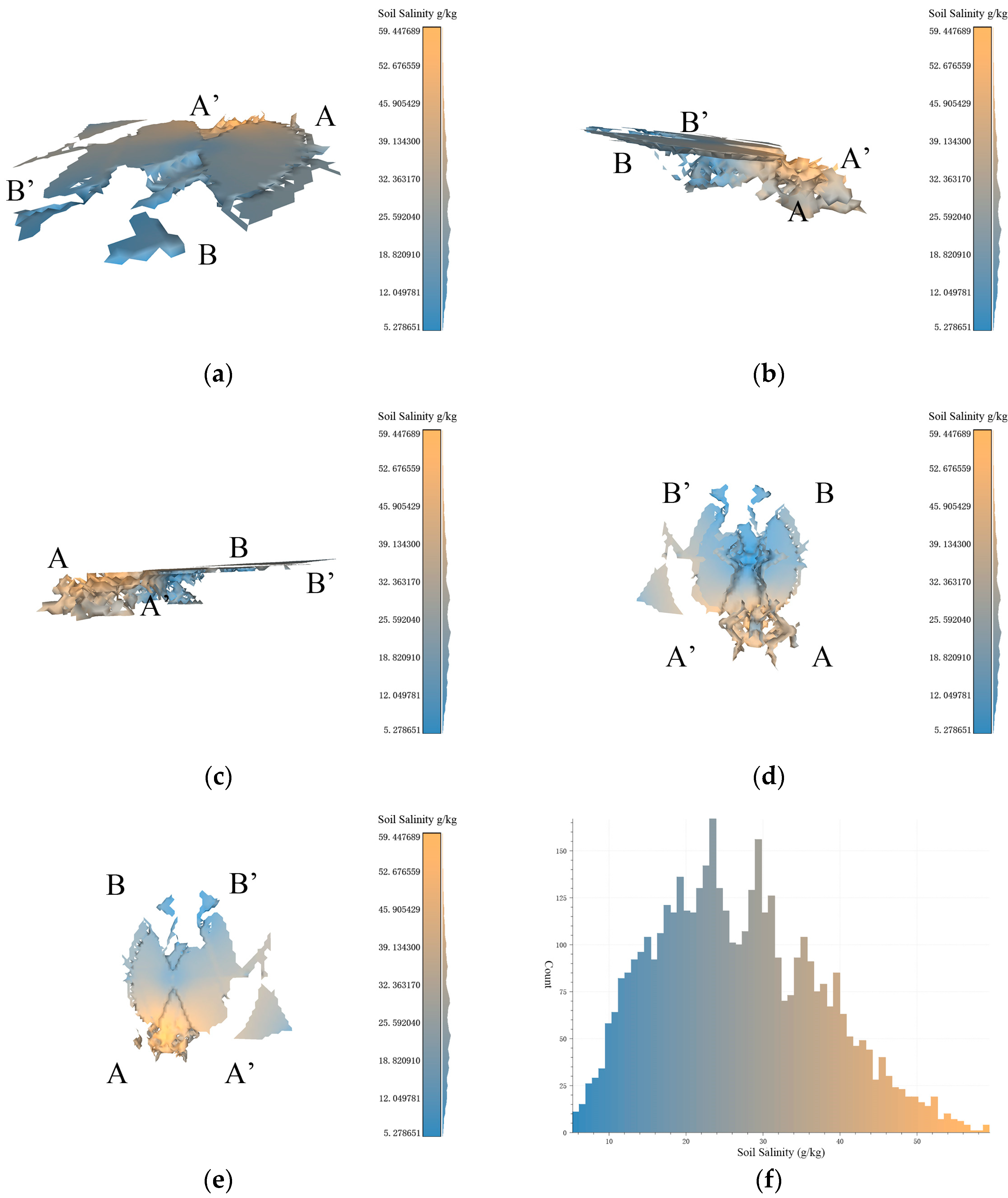
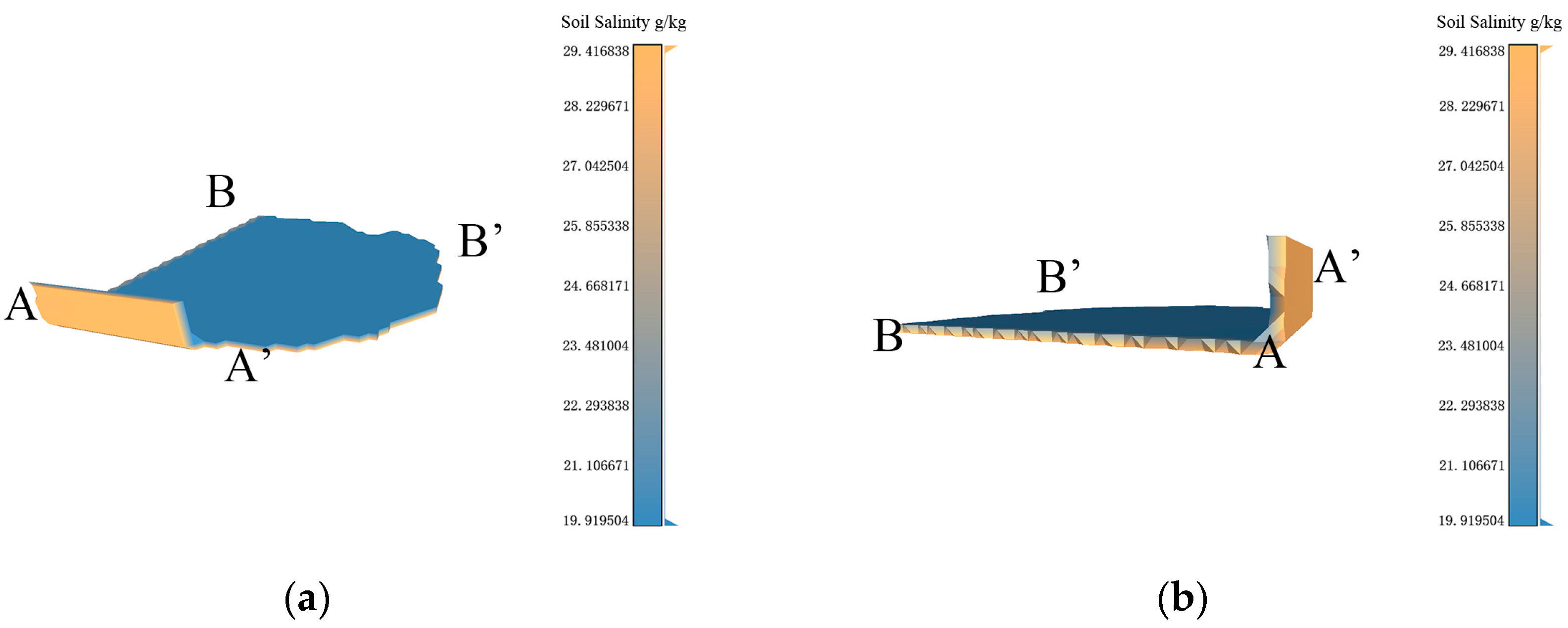

| Point ID | X | Y | Depth 0–10 cm Salt Content (g/kg) | Depth 10–20 cm Salt Content (g/kg) | Depth 20–30 cm Salt Content (g/kg) | Depth 30–40 cm Salt Content (g/kg) | Depth 40–50 cm Salt Content (g/kg) | Depth 50–60 cm Salt Content (g/kg) | Depth 60–70 cm Salt Content (g/kg) | Depth 70–80 cm Salt Content (g/kg) | Depth 80–90 cm Salt Content (g/kg) | Depth 90–100 cm Salt Content (g/kg) |
|---|---|---|---|---|---|---|---|---|---|---|---|---|
| 1 | 118.3791611 | 37.5156285 | 0.75 | 0.7 | 0.7 | 0.7 | 1 | 1.25 | 1 | 1 | 1.05 | 1.05 |
| 2 | 118.3780168 | 37.56238133 | 0.65 | 0.55 | 0.55 | 0.5 | 0.55 | 0.65 | 0.9 | 1.1 | 1.15 | 1.3 |
| 3 | 118.4345917 | 37.515872 | 0.6 | 0.6 | 0.7 | 1.5 | 2.7 | 2.7 | 6.65 | 4.25 | 3.85 | 4.25 |
| 9 | 118.6094112 | 37.52716367 | 0.5 | 0.35 | 0.3 | 0.45 | 0.55 | 1 | 0.95 | 0.95 | 1.3 | 1.5 |
| 12 | 118.6602988 | 37.5521445 | 66.75 | 24.05 | 11.8 | 9.85 | 9.25 | 8.5 | 9.35 | 9.2 | 9.9 | 10.65 |
| 36 | 118.8368983 | 37.82592267 | 2.5 | 2.3 | 2.2 | 1.75 | 1.75 | 1.75 | 1.5 | 1.4 | 1.65 | 1.75 |
| 50 | 118.9510483 | 37.77861033 | 1.55 | 1.55 | 1.55 | 1 | 1.45 | 0.9 | 0.7 | 0.7 | 0.5 | 0.6 |
| 62 | 119.0192367 | 37.69066533 | 43.1 | 15.8 | 11.35 | 11.15 | 7.15 | 9.5 | 9.65 | 12 | 11.85 | 11.7 |
| Soil Depth (/cm) | Minimum (g/kg) | Maximum (g/kg) | Mean (g/kg) | Median (g/kg) | Standard Deviation (g/kg) | Coefficient of Variation | Skewness | Kurtosis |
|---|---|---|---|---|---|---|---|---|
| 0–10 | 0.300 | 61.250 | 12.899 | 1.925 | 18.435 | 1.429 | 1.428 | 0.710 |
| 10–20 | 0.150 | 30.050 | 5.826 | 1.975 | 7.939 | 1.363 | 1.678 | 1.949 |
| 20–30 | 0.250 | 31.250 | 5.346 | 2.125 | 6.842 | 1.280 | 1.767 | 2.831 |
| 30–40 | 0.200 | 26.700 | 5.117 | 2.125 | 6.214 | 1.215 | 1.761 | 2.981 |
| 40–50 | 0.250 | 23.950 | 4.822 | 2.450 | 5.377 | 1.115 | 1.631 | 2.451 |
| 50–60 | 0.300 | 23.850 | 4.927 | 2.700 | 5.432 | 1.102 | 1.573 | 1.930 |
| 60–70 | 0.250 | 25.500 | 5.017 | 2.950 | 5.231 | 1.043 | 1.639 | 2.769 |
| 70–80 | 0.250 | 27.550 | 5.038 | 3.300 | 5.490 | 1.090 | 2.111 | 5.316 |
| 80–90 | 0.250 | 23.150 | 4.860 | 3.500 | 5.235 | 1.077 | 2.746 | 11.167 |
| 90–100 | 0.250 | 17.950 | 5.285 | 3.425 | 6.540 | 1.238 | 3.036 | 11.733 |
| 0–100 | 0.150 | 61.250 | 5.928 | 2.900 | 8.532 | 1.439 | 3.153 | 12.961 |
Disclaimer/Publisher’s Note: The statements, opinions and data contained in all publications are solely those of the individual author(s) and contributor(s) and not of MDPI and/or the editor(s). MDPI and/or the editor(s) disclaim responsibility for any injury to people or property resulting from any ideas, methods, instructions or products referred to in the content. |
© 2024 by the authors. Licensee MDPI, Basel, Switzerland. This article is an open access article distributed under the terms and conditions of the Creative Commons Attribution (CC BY) license (https://creativecommons.org/licenses/by/4.0/).
Share and Cite
Han, Z.; Fu, X.; Yu, J.; Zhang, H. Detecting 3D Salinity Anomalies from Soil Sampling Points: A Case Study of the Yellow River Delta, China. Land 2024, 13, 1488. https://doi.org/10.3390/land13091488
Han Z, Fu X, Yu J, Zhang H. Detecting 3D Salinity Anomalies from Soil Sampling Points: A Case Study of the Yellow River Delta, China. Land. 2024; 13(9):1488. https://doi.org/10.3390/land13091488
Chicago/Turabian StyleHan, Zhoushun, Xin Fu, Jianing Yu, and Hengcai Zhang. 2024. "Detecting 3D Salinity Anomalies from Soil Sampling Points: A Case Study of the Yellow River Delta, China" Land 13, no. 9: 1488. https://doi.org/10.3390/land13091488






